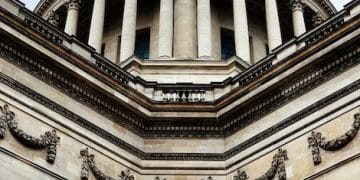Dodd-Frank Act Update: Key Provisions & Impact on Financial Institutions in 2025

The updated Dodd-Frank Act regulations in 2025 focus on enhanced oversight, stress testing, and resolution planning for financial institutions, aiming to bolster stability and prevent systemic risk through increased transparency and accountability.
Navigating the complexities of financial regulations is a constant challenge for institutions. As we look ahead to 2025, understanding `What are the Key Provisions of the Updated Dodd-Frank Act Regulations and Their Impact on Financial Institutions in 2025?` becomes paramount for strategic planning and compliance.
Understanding the Dodd-Frank Act: A Brief Overview
The Dodd-Frank Wall Street Reform and Consumer Protection Act, enacted in 2010, fundamentally reshaped the U.S. financial regulatory landscape. Designed to prevent a repeat of the 2008 financial crisis, it introduced a wide range of measures impacting everything from bank capital requirements to consumer protection.
Before delving into the specific updates expected in 2025, it’s essential to understand the Act’s original intent and key pillars.
Core Objectives of the Dodd-Frank Act
The Dodd-Frank Act aimed to achieve several key objectives that would hopefully enhance the stability and transparency of the US financial system.
- Promoting Financial Stability: Reducing systemic risk by increasing oversight of financial institutions and activities.
- Protecting Consumers: Establishing the Consumer Financial Protection Bureau (CFPB) to safeguard consumers from abusive financial practices.
- Ending “Too Big to Fail”: Implementing mechanisms for the orderly liquidation of failing financial institutions without taxpayer bailouts.
- Increasing Transparency: Requiring greater disclosure of financial information and activities.
The act addresses various aspects of the financial industry, requiring companies of all sizes to re-evaluate their own procedures.

Key Updates to Dodd-Frank Regulations Expected in 2025
As financial markets evolve and new risks emerge, regulatory frameworks must adapt. Several updates to the Dodd-Frank Act are anticipated in 2025, reflecting lessons learned and the changing landscape of the financial industry.
These updates are expected to address gaps in existing regulations and enhance the Act’s effectiveness in mitigating risks.
Enhanced Oversight of Systemically Important Financial Institutions (SIFIs)
One area of focus is expected to be enhanced oversight of Systemically Important Financial Institutions (SIFIs). Financial institutions that are considered too big to fail will be constantly under watch.
- Stricter Capital Requirements: Increasing the amount of capital SIFIs must hold to absorb potential losses.
- Enhanced Stress Testing: Requiring more frequent and rigorous stress tests to assess the resilience of SIFIs under adverse economic scenarios.
- Living Wills: Ensuring that SIFIs have credible plans for their orderly resolution in the event of failure.
These updated oversights should leave the financial world much more prepared to handle an economic meltdown.
Impact on Community Banks and Smaller Institutions
While the Dodd-Frank Act primarily targets large financial institutions, community banks and smaller institutions are not immune to its effects. The regulatory burden imposed by the Act can disproportionately impact smaller institutions, which may have limited resources to comply with complex rules.
Understanding how these regulations affect smaller players is vital for ensuring a healthy and balanced financial ecosystem.
Tailoring Regulations for Smaller Institutions
Regulators are increasingly recognizing the need to tailor regulations to the size and complexity of financial institutions. This involves exempting smaller institutions from certain requirements and simplifying compliance processes.
- Exemptions from Volcker Rule: Providing exemptions from the Volcker Rule, which restricts banks from engaging in certain proprietary trading activities.
- Simplified Reporting Requirements: Reducing the frequency and complexity of reporting requirements for smaller institutions.
- Community Bank Leverage Ratio (CBLR): Allowing qualifying community banks to opt into a simplified leverage ratio requirement.
These measures are aimed at reducing the regulatory burden on community banks and allowing them to focus on serving their local communities.
The Role of Technology and Fintech in Regulatory Compliance
Technology and fintech are playing an increasingly important role in regulatory compliance. Financial institutions are leveraging technology to automate compliance processes, improve data management, and enhance risk management.
The integration of technology offers the potential to streamline compliance efforts and reduce costs.
Regtech Solutions for Dodd-Frank Compliance
Regtech, or regulatory technology, is a growing industry focused on providing technology solutions to help financial institutions comply with regulations.
- Automated Reporting: Automating the process of generating and submitting regulatory reports.
- Data Analytics: Using data analytics to identify and monitor potential compliance risks.
- Risk Management Systems: Implementing systems to assess and manage risks associated with financial activities.
By adopting regtech solutions, financial institutions can improve the efficiency and effectiveness of their compliance efforts.
Consumer Protection and the CFPB
The Dodd-Frank Act established the Consumer Financial Protection Bureau (CFPB) to protect consumers from abusive financial practices. The CFPB has broad authority to regulate financial products and services, enforce consumer protection laws, and educate consumers about their rights.
The CFPB plays a critical role in ensuring that consumers are treated fairly in the financial marketplace.

CFPB’s Focus Areas in 2025
In 2025, the CFPB is expected to focus on several key areas that are important for consumers throughout the US.
- Mortgage Lending: Ensuring that mortgage lenders comply with fair lending laws and avoid discriminatory practices.
- Debt Collection: Protecting consumers from abusive debt collection practices.
- Payday Lending: Regulating payday lenders and other high-cost lenders to prevent predatory lending.
The CFPB’s efforts are aimed at creating a fairer and more transparent financial marketplace for consumers.
Preparing for 2025: Strategies for Financial Institutions
As financial institutions prepare for the updated Dodd-Frank Act regulations in 2025, proactive planning and strategic decision-making are essential. Institutions that take steps to understand and comply with the new regulations will be better positioned to thrive in the evolving financial landscape.
Preparation and foresight are going to be the bread and butter of any successful financial institution.
Key Steps for Compliance
There are several key steps that your institution can take to ensure that it is compliant by 2025.
- Assess the Impact: Conduct a thorough assessment of the potential impact of the updated regulations on your institution.
- Develop a Compliance Plan: Develop a comprehensive compliance plan that outlines the steps your institution will take to comply with the new regulations.
- Invest in Technology: Invest in technology solutions to automate compliance processes and improve data management.
By taking these steps, financial institutions can minimize disruption and ensure a smooth transition to the new regulatory environment.
In conclusion, the Dodd-Frank Act is intended to make the financial landscape much safer.
| Key Point | Brief Description |
|---|---|
| 🛡️ Enhanced Oversight | Increased monitoring of SIFIs to prevent systemic risks. |
| 🏦 Tailored Regulations | Adjustments for smaller institutions to ease compliance burdens. |
| 💻 Regtech Solutions | Use of technology to automate and improve regulatory compliance. |
| ✅ Consumer Protection | CFPB efforts to safeguard consumers from unfair financial practices. |
Frequently Asked Questions
▼
The Dodd-Frank Act aims to promote financial stability, protect consumers, end “too big to fail,” and increase transparency within the U.S. financial system.
▼
Community banks may face disproportionate regulatory burdens due to limited resources for compliance, but regulators are offering tailored regulations to help streamline this.
▼
Technology, particularly regtech solutions, helps automate reporting, analyze data for risks, and manage compliance processes more efficiently for financial institutions.
▼
Consumers benefit as the CFPB protects them from abusive financial practices, regulates products and services, and educates them about their financial rights.
▼
Banks can assess the impacts of the updated regulations, create a compliance plan, and invest in technology to adapt to the new requirements.
Conclusion
As we look to 2025, understanding and preparing for the updated Dodd-Frank Act regulations is critical for financial institutions. By staying informed, embracing technology, and prioritizing compliance, institutions can navigate the evolving regulatory landscape and contribute to a more stable and resilient financial system.





